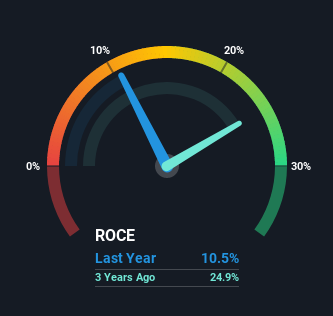Core Laboratories (NYSE:CLB) May Have Issues Allocating Its Capital
Ignoring the stock price of a company, what are the underlying trends that tell us a business is past the growth phase? When we see a declining return on capital employed (ROCE) in conjunction with a declining base of capital employed, that's often how a mature business shows signs of aging. This reveals that the company isn't compounding shareholder wealth because returns are falling and its net asset base is shrinking. On that note, looking into Core Laboratories (NYSE:CLB), we weren't too upbeat about how things were going.
What is Return On Capital Employed (ROCE)?
If you haven't worked with ROCE before, it measures the 'return' (pre-tax profit) a company generates from capital employed in its business. To calculate this metric for Core Laboratories, this is the formula:
Return on Capital Employed = Earnings Before Interest and Tax (EBIT) ÷ (Total Assets - Current Liabilities)
0.11 = US$53m ÷ (US$598m - US$91m) (Based on the trailing twelve months to June 2021).
So, Core Laboratories has an ROCE of 11%. On its own, that's a standard return, however it's much better than the 5.6% generated by the Energy Services industry.
Check out our latest analysis for Core Laboratories
In the above chart we have measured Core Laboratories' prior ROCE against its prior performance, but the future is arguably more important. If you're interested, you can view the analysts predictions in our free report on analyst forecasts for the company.
What The Trend Of ROCE Can Tell Us
In terms of Core Laboratories' historical ROCE movements, the trend doesn't inspire confidence. To be more specific, the ROCE was 28% five years ago, but since then it has dropped noticeably. Meanwhile, capital employed in the business has stayed roughly the flat over the period. Companies that exhibit these attributes tend to not be shrinking, but they can be mature and facing pressure on their margins from competition. So because these trends aren't typically conducive to creating a multi-bagger, we wouldn't hold our breath on Core Laboratories becoming one if things continue as they have.
What We Can Learn From Core Laboratories' ROCE
In summary, it's unfortunate that Core Laboratories is generating lower returns from the same amount of capital. Long term shareholders who've owned the stock over the last five years have experienced a 70% depreciation in their investment, so it appears the market might not like these trends either. Unless there is a shift to a more positive trajectory in these metrics, we would look elsewhere.
If you want to know some of the risks facing Core Laboratories we've found 3 warning signs (1 is significant!) that you should be aware of before investing here.
While Core Laboratories may not currently earn the highest returns, we've compiled a list of companies that currently earn more than 25% return on equity. Check out this free list here.
This article by Simply Wall St is general in nature. It does not constitute a recommendation to buy or sell any stock, and does not take account of your objectives, or your financial situation. We aim to bring you long-term focused analysis driven by fundamental data. Note that our analysis may not factor in the latest price-sensitive company announcements or qualitative material. Simply Wall St has no position in any stocks mentioned.
Have feedback on this article? Concerned about the content? Get in touch with us directly. Alternatively, email editorial-team (at) simplywallst.com.

